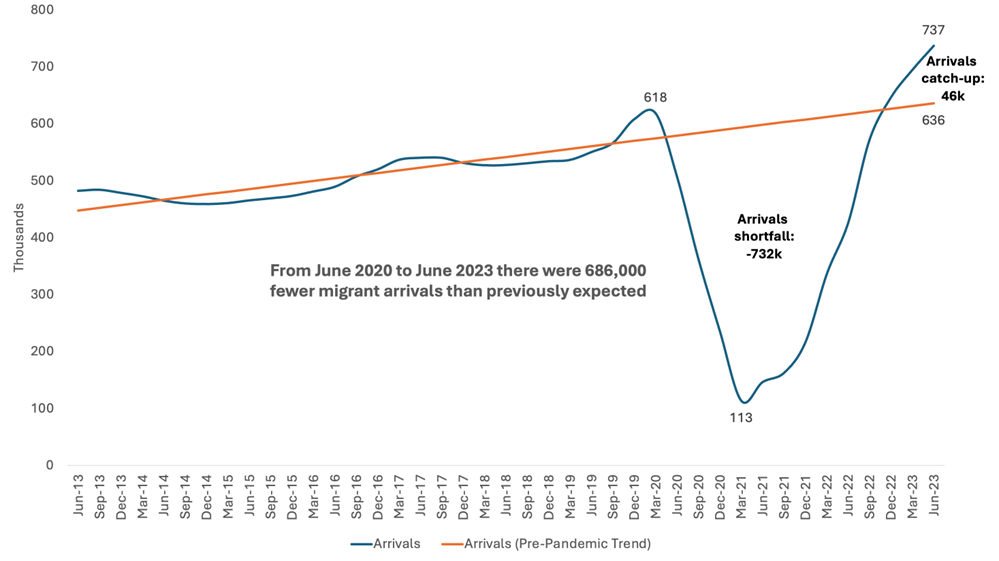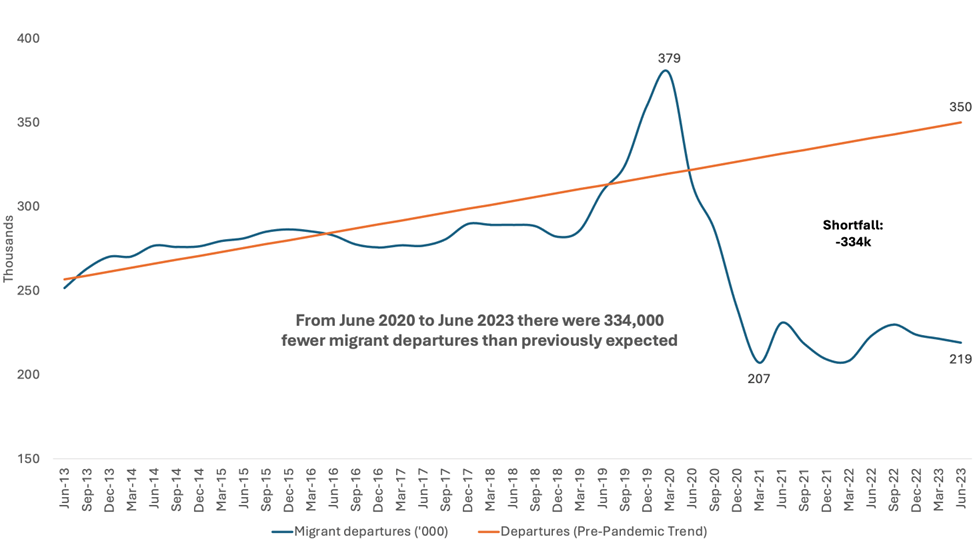
Explaining the 2024 Net Overseas Migration surge
A recent surge in net overseas migration (NOM) has become a hot topic, with politicians and media commentators linking the surge with limited housing supply and other pressures. But what is the NOM? And do we really have unusually high volumes of migration? Alan Gamlen explains.
Read time: 7 mins
By Alan Gamlen, Director of the ANU Migration Hub.
A recent surge in net overseas migration (NOM) has become a hot topic in the wash-up of the 2024 Budget. Politicians and media commentators are linking the surge with soaring housing costs.
However, this concern is misplaced. Most people think the NOM surge means we have unusually high volumes of migration. But it’s the exact opposite. So what does explain the NOM surge?
What is the NOM surge?
Net Overseas Migration (NOM) is calculated by subtracting overseas departures from overseas arrivals. Arrivals – Departures = NOM.
People often confuse NOM with permanent migration, which is just a small, capped part of NOM. NOM also includes flows the government can’t cap, like people departing and Australians returning home. So NOM is bigger than just permanent migration.
Public discourse has traditionally focused on the smaller permanent migration figures, and people are unused to hearing much about NOM. They are now hearing the larger NOM figures without really knowing what these figures mean, which is causing some misplaced concerns.
NOM always fluctuates as migrant arrivals and departures change over time. But around that natural fluctuation, NOM was quite stable until the pandemic, adding around 220,000 to Australia’s population per year for at least a decade.
Without these added people, Australia’s population would rapidly age and shrink, with too few working age people to support our large elderly population, leading to a rapid economic decline known as a ‘demographic winter’.
However, during the pandemic, something happened to NOM that we’d never seen since World War 1. NOM suddenly spiked downward, then upward. That’s the NOM surge.
Why is the NOM surge happening?
The root cause of the NOM surge is that the COVID-19 pandemic drastically reduced all migration flows – both in and out of Australia. To understand the disruption, we must examine three key trends: migrant arrivals, migrant departures, and net overseas migration.
In the year to March 2020, migrant arrivals were just over 618,000. Then the world went into lockdown, and over the next year migrant arrivals spiked down by 82 per cent to 113,000 (Figure 1).
Figure 1: Migrant arrivals from 2013 to 2023

Then, when the pandemic subsided, arrivals rebounded to just over 737,000 in the year to June 2023. That’s 16 per cent above where we previously expected them to be by now. A bit high, but not crazy high.
Note that the down-spike was much, much larger than the up-spike (Figure 1). From June 2020 to June 2023, Australia received 686,000 fewer migrant arrivals than previously expected.
Wait a minute, did you just say arrivals have been way lower than expected? Then how come we have a migration surge? Good question. The answer is: departures.
Figure 2. Migrant departures from 2013 to 2023

NOM is just arrivals minus departures. So, there are two ways NOM can grow: arrivals increase, or departures shrink. And as we’ve just shown, arrivals haven’t grown.
However, departures did shrink during COVID, because the Coalition Government extended temporary visas. That meant fewer people on temporary visas departed from Australia.
These extensions have not all expired yet. As a result, departures are still at historic lows (Figure 2). From June 2020 to June 2023, there were 334,000 fewer migrant departures than previously expected.
When we add the small recent arrivals rebound to the prolonged shortage of departures, we get the recent NOM surge. We expected NOM to be at 286,000 – instead it’s up to 518,000.
But here’s the thing: the current NOM up-spike is still way smaller than the NOM down-spike that happened during the pandemic (Figure 3). On the whole, we got 352,000 fewer people through net migration than we previously expected we’d have gotten by now.
Figure 3: Net overseas migration from 2013 to 2023

What are they going to do about the NOM surge?
There is a lot of concern amongst politicians, media and the general public, who worry that the NOM surge is inflating Australia’s housing prices. The ANU Migration Hub will discuss this issue in our briefing in early June. Spoiler alert: Migration is a small piece of the housing puzzle.
However, because of the perceived connection between NOM and housing prices, both main political parties are focusing on migration as a battleground issue for the 2025 election campaign.
The Opposition made several contradictory statements about its NOM targets during the Budget debate. Opposition Leader Peter Dutton’s Budget Reply did not specify a NOM target, but in subsequent interviews he promised to cut NOM to 160,000 per year. Later, Shadow Treasurer Angus Taylor contradicted this.
What should I do about the NOM surge?
Honestly, probably worry less about it.
Over the past four years there have been way fewer arrivals, way fewer departures, and way less NOM than we previously expected we’d have by this time. We’ve had a lot less migration, not more.
There is a temporary NOM spike because arrivals have recovered faster than departures. Departures haven’t recovered yet because of visa extensions granted by the Coalition during the pandemic.
It’s highly likely the NOM surge will naturally subside over the medium term. This is because departures will rise as pandemic-era visa extensions expire. Meanwhile, arrivals will fall after they catchup from the pandemic.
At any rate, that’s how I learned to stop worrying and love the NOM.
